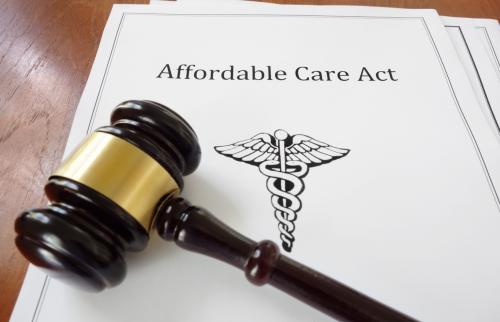This white paper is part of the USC-Brookings Schaeffer Initiative for Health Policy, which is a partnership between the Economic Studies Program at Brookings and the USC Schaeffer Center for Health Policy & Economics. The Initiative aims to inform the national health care debate with rigorous, evidence-based analysis leading to practical recommendations using the collaborative strengths of USC and Brookings.
With Medicare spending growth over the next decade expected to exceed GDP growth,1 the trust fund projected to be depleted in 2026,23 and evidence of persistent and pervasive waste and disparities in health care,4 attention has returned to the role of payment reform in controlling Medicare spending growth and driving more efficient and equitable care delivery. There is broad agreement that progress will require a renewed push by policymakers to move provider payment in Medicare away from fee-for-service (FFS) reimbursement toward alternative payment models (APMs) in which providers receive a budget for the care of a population or an episode and gain financially from efficiencies they generate.567
After a decade of activity in this direction, momentum has stalled. Participation in the Shared Savings Program (SSP) — the largest accountable care organization (ACO) initiative in Medicare — has been essentially flat since 2018 after a period of rapid expansion.8 The Next Generation ACO model will end this year after failing to meet statutory savings requirements for expansion.9 The newest ACO model fielded by the Center for Medicare & Medicaid Innovation (CMMI), Direct Contracting, has maintained some momentum but remains small. Currently, approximately 12.1 million beneficiaries are aligned to an organization in one of these population-based programs, or 39.5% of those fully enrolled in traditional FFS Medicare (TM).10Overall, early net savings to Medicare generated by ACO models have not clearly grown and may have regressed.14 15
There is clear consensus on the goals of payment reform (fiscal sustainability, higher-value care, and equity) and the need for a more coordinated and effective APM portfolio to achieve those goals.1112131415The Centers for Medicare and Medicaid Services (CMS) recently reaffirmed the agency’s commitment to develop APMs as a core element of its strategic vision.16 Consistent with calls from others including the Medicare Payment Advisory Commission, CMS and CMMI leadership articulated the need to move beyond the let-many-flowers-bloom and test-and-diffuse approaches that, understandably, characterized the first decade of payment reform efforts and towards a streamlined, synergistic set of APMs designed to transform care.
There has been less discussion about the design of such a portfolio. Yet it has been the design of APMs that has limited participation and savings to date. Indeed, in their strategic review, CMS and CMMI leadership noted how technical aspects of model design are critical to success.17 Similarly, advancing health equity has been appropriately embraced as a central goal of APMs, but exactly how APMs can be designed to effectively promote health equity remains underdeveloped.
To help advance the conversation from high-level principles to a more concrete vision of a future payment system in TM, in this paper we provide a sketch of a multi-track population-based payment model designed to serve as a foundational piece of that system. While we focus on the structure of a population-based payment system, we acknowledge the important complementary role that episode-based payment can play and envision strategic deployment of episode-based payments integrated with the population-based model we propose. That said, we limit discussion of episode-based payments to general considerations, as the details of how they should be designed and integrated are complex and beyond the scope of this paper. We do note that many of the design issues we discuss (e.g., around benchmarks) apply analogously to episode-based payments.
We start with some background on the importance of payment reform in TM and design lessons from APMs to date. We then sketch our proposed payment system and discuss the rationale for its key features. We do not discuss the tactical issues of how to transition to the APM environment we envision (i.e., how to refine and coordinate existing models), focusing instead on design considerations.
Our vision includes the following recommendations for a multi-track population-based payment model, which we lay out in our sketch of the model’s major elements (tracks, participation incentives, benchmarks, risk adjustment and health equity, and ACO definition):
Recommendation #1: Define a parsimonious set of tracks that:
- Accommodates different types of providers
- Permanently avails a low-risk option for eligible (smaller) organizations to promote entry of innovative delivery models and encourage participation by providers that do not need much downside risk to have strong incentives to lower spending
- Restricts options for large organizations to tracks with high levels of population-based risk.
Recommendation #2: Establish stronger participation incentives for providers, and particularly strong incentives for large organizations. Possible examples of policies that would strengthen participation incentives might include:
- Applying site neutral payments to hospitals in non-participating health systems
- Excluding hospitals in non-participating health systems from the 340B Drug Pricing Program
- Offering primary care capitation payments above current levels of primary care spending
- Allowing payment parity for telemedicine to expire at the conclusion of the public health emergency
Recommendation #3: Set benchmarks in a way that provides an “on-ramp” for ACOs with high spending, allows divergence from observed FFS spending, is unaffected by an ACO’s own performance, and thereby strengthens incentives for participation and long-term savings.
Recommendation #4: Improve risk adjustment systems to limit profits from coding.
Recommendation #5: Promote health equity by:
-
- Allocating more resources through the payment system to underserved and/or socially disadvantaged groups (via risk adjustment that departs from the statistical goal of predicting spending to set payment according to social goals)
- Giving ACOs flexibility to attract those groups with beneficiary enhancements that address disparities.
Recommendation #6: Revise the definition of ACOs to reflect organizations as defined by ownership to: limit gains from strategic participation by parts of organizations, promote collection of data on provider ownership, and support antitrust efforts to monitor the implications of ACO contracting for competition.
Download the full report here.
Acknowledgements and Disclosures:
This work was supported by a grant from Arnold Ventures. The content is based solely on the authors’ analysis and conclusions and do not necessarily represent the official views of Arnold Ventures. We thank Matt Fiedler, Patrick Conway, Chris Dawe, Tim Gronniger, and Farzad Mostashari for comments on an earlier draft.
Dr. McWilliams reports receiving personal fees from the Medicare Payment Advisory Commission (consulting contractor), Abt Associates, Inc. (consultant), JAMA Internal Medicine (Associate Editor), and the Center for Medicare & Medicaid Innovation (Senior Advisor); and serving on the academic advisory board for FAIR Health and the board of directors for the Institute for Accountable Care. Dr. Chen reports personal fees from Novartis and Pfizer. Dr. Chernew reports research grants from Blue Cross Blue Shield Association, Health Care Service Corporation, Ballad Health, Signify Health LLC; personal fees from MJH Life Sciences (American Journal of Managed Care), Elsevier, MITRE, American Economic Review, Commonwealth Fund, IDC Herzliya, Madalena Consulting, Chilmark Research, American College of Cardiology, Health(at)Scale, Blue Cross Blue Shield of Florida, Medaxiom, Humana, American Medical Association, America’s Health Insurance Plans, HealthEdge, RTI Health Solutions, Emory University, Washington University, and University of Pennsylvania; equity in V-BID Health (partner), Virta Health, Archway Health, Curio Wellness (board of directors), Station Health, and Health(at)Scale; serving (or served) on advisory boards for Congressional Budget Office (panel of health advisors), National Institute for Health Care Management, National Academies, AcademyHealth, National Quality Forum, Blue Cross Blue Shield Association, and Blue Health Intelligence; serving as a board member for Health Care Cost Institute, as Vice Chair for the Massachusetts Health Connector, and as the current Chair of Medicare Payment Advisory Commission. All opinions expressed are those of the authors and not any organization which they are affiliated with.
-
Footnotes
- National Health Expenditure Projections 2019–28. Center for Medicare and Medicaid Services; Accessed August 20, 2021. https://www.cms.gov/files/document/national-healthexpenditure-projections-2019-28.pdf
- Cubanski J, Neuman T. FAQs on Medicare Financing and Trust Fund Solvency.; 2021. Accessed August 20, 2021. https://www.kff.org/medicare/issue-brief/faqs-on-medicare-financing-and-trustfund-solvency/
- Cubanski J, Neuman T, Freed M. The Facts on Medicare Spending and Financing. KFF; 2019.Accessed August 20, 2021. https://www.kff.org/medicare/issue-brief/the-facts-on-medicarespending-and-financing/
- IOM (Institute of Medicine). The Healthcare Imperative: Lowering Costs and Improving Outcomes: Workshop Series Summary. In: The National Academies Press; 2010. doi:10.17226/12750
- Burwell SM. Setting Value-Based Payment Goals — HHS Efforts to Improve U.S. Health Care. N Engl J Med. 2015;372:897-899. doi:10.1056/NEJMp1500445
- Medicare alternative payment models. American Medical Association. Accessed August 20, 2021. https://www.ama-assn.org/practice-management/payment-delivery-models/medicare-alternativepayment-models
- March 2021 Report to the Congress: Medicare Payment Policy. MedPAC (Medicare Payment Advisory Commission); 2021. Accessed August 20, 2021. http://medpac.gov/docs/defaultsource/reports/mar21_medpac_report_to_the_congress_sec.pdf
- 2021 Shared Savings Program Fast Facts. Center for Medicare and Medicaid Services; 2021:2. Accessed August 20, 2021. https://www.cms.gov/files/document/2021-shared-savings-programfast-facts.pdf
- Yood K. CMS’ Next Generation Accountable Care Organization (NGACO) Model Set To End in December 2021. The National Law Review. Published June 2, 2021. Accessed August 20, 2021. https://www.natlawreview.com/article/cms-next-generation-accountable-care-organization-ngacomodel-set-to-end-december
- Medicare Enrollment Dashboard | CMS. Center for Medicare and Medicaid Services. Published January 22, 2021. Accessed August 20, 2021. https://www.cms.gov/Research-Statistics-Data-andSystems/Statistics-Trends-and-Reports/CMSProgramStatistics/Dashboard
- Chernew ME. A Path Forward for Alternative Payment: Build a Portfolio Not a Garden. JAMA Health Forum. 2021;2(5):e210232-e210232. doi:10.1001/jamahealthforum.2021.0232
- Werner RM, Emanuel E, Pham HH, Navathe AS. The Future of Value-Based Payment: A Road Map to 2030. Leonaqrd Davis Institute of Health Economics; 2021:24. Accessed August 20, 2021. https://ldi.upenn.edu/our-work/research-updates/the-future-of-value-based-payment-a-road-mapto-2030/
- Navathe AS, Emanuel EJ, Glied S, Mostashari F, Kocher B. Medicare Payment Reform’s Next Decade: A Strategic Plan For The Center For Medicare And Medicaid Innovation | Health Affairs Blog. Health Affairs Blog. Published December 18, 2020. Accessed August 20, 2021. https://www.healthaffairs.org/do/10.1377/hblog20201216.672904/full/
- Berwick DM, Gilfillan R. Reinventing the Center for Medicare and Medicaid Innovation. JAMA. 2021;325(13):1247-1248. doi:10.1001/jama.2021.3203
- June 2021 Report to the Congress: Medicare and the Health Care Delivery System. MedPAC (Medicare Payment Advisory Commission); 2021. Accessed August 20, 2021.http://www.medpac.gov/docs/defaultsource/reports/jun21_medpac_report_to_congress_sec.pdf?sfvrsn=0
- Brooks-LaSure C, Fowler E, Seshamani M, Tsai D. Innovation At The Centers For Medicare And Medicaid Services: A Vision For The Next 10 Years. Health Affairs Blog. Published August 12, 2021. Accessed August 20, 2021. https://www.healthaffairs.org/do/10.1377/hblog20210812.211558/full/
- Brooks-LaSure C, Fowler E, Seshamani M, Tsai D. Innovation At The Centers For Medicare And Medicaid Services: A Vision For The Next 10 Years. Health Affairs Blog. Published August 12, 2021. Accessed August 20, 2021. https://www.healthaffairs.org/do/10.1377/hblog20210812.211558/full/
The Brookings Institution is committed to quality, independence, and impact.
We are supported by a diverse array of funders. In line with our values and policies, each Brookings publication represents the sole views of its author(s).






